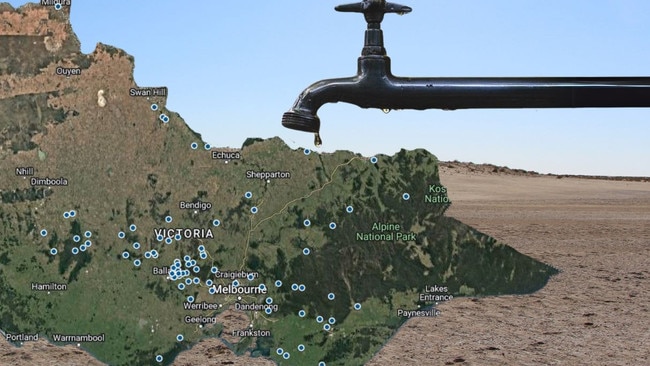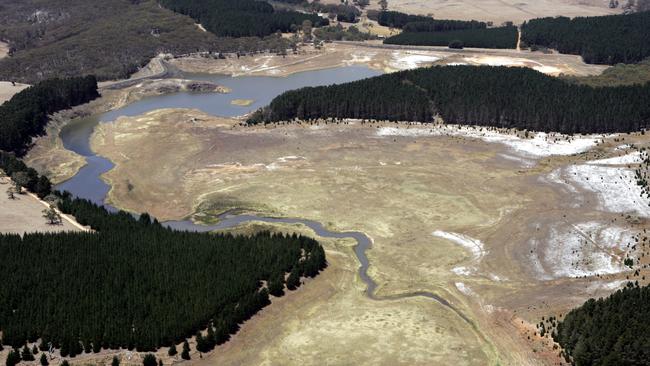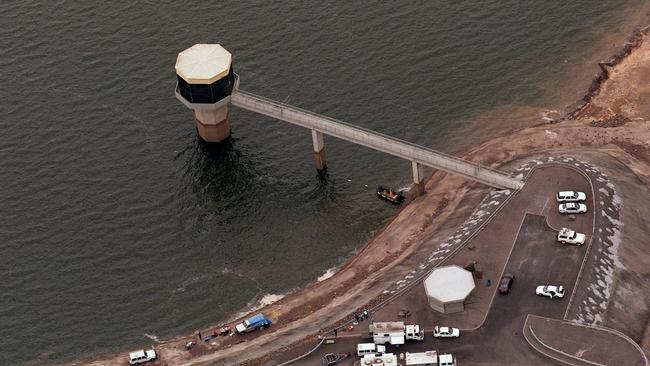Victorian water storages decrease by 3.4m megalitres in year to April 2025
Despite optimism that rain is on the way, Victorian farmers are bracing for a challenging season as water levels drop significantly across the state.

Goulburn Valley
Don't miss out on the headlines from Goulburn Valley. Followed categories will be added to My News.
Victorian farmers have “faith” the rains are coming but are nevertheless preparing for a “challenging season” as dams dry up and reservoir levels drop by as much as 60 per cent.
And while Melburnians aren’t likely to face strict water restrictions this year, below average rainfall has left authorities encouraging those in the suburbs to save where they can.
Water storages across the state have lost the equivalent of 1.3 million Olympic swimming pools worth of water in a year, the latest statistics reveal.
Victorian Farmers Federation president Brett Hosking said with no big summer storms to support water storages, farmers were looking skyward and hoping for an autumn break.
“It gives farmers confidence about what the year’s going to do but we haven’t seen that yet,” he said.
“Usually by mid-May if we’re not seeing a break across reasonable parts of Victoria, we start to do our belts up and say ‘all right, we could be in for a more challenging season’.”
It had already gotten so bad for dairy farmers in the state’s southwest, he said, that dams and other farm water storages were drying up.
“It means even if you’ve got feed in the paddock you can’t support those cattle because water is the most essential ingredient for animal health,” he said.
Already, he added, farmers were bringing in water from elsewhere.
“Quite often I drive down to Bendigo and there’ll nearly always be somebody at the stand pipe filling up a water tank to cart back to their homes just to make sure they’ve got drinking water,” he said.
Mr Hosking said instead of waiting for rain and then sowing (which helps seeds germinate faster), some grain farmers were starting to sow dry — a system they had “down pat”.
“The challenge is that it’s a very expensive time of a year with the seed we’re putting in the ground, herbicides, pesticides, fuel, and the fertiliser,” he said.
“That’s all being done on faith that history tells us it will rain and the crop will get up and out of the ground.”

Mr Hosking said while there had not been rain yet there were positive climate signals with rain in northern Australia and warming in the Indian Ocean.
“Typical farmers, we’re optimistic, and we’re watching the weather,” he said.
But Bureau of Meteorology climatology specialist Qian Zhou said the dry weather could very likely continue.
“In 2024, and so far in 2025, our weather patterns have been dominated by high pressure systems moving across southern Australia,” she said.
“This has allowed the build up of the warm and dry conditions, with fewer outbreaks of cold air or rain-bearing weather systems affecting the state.”
And it was likely to continue, she said, noting there was an increased likelihood of below-average rain for much of the west, and scattered areas in the central and northeast between May and July.
Most of Victoria has had above to very much above average maximum temperatures so far this year, with the amount of rain ranging between below to very much below average.
Gippsland was the exception.
Ms Zhou said factors that could influence water storages included rain, water withdrawals, sediment build up and climate change.
“In terms of the potential impacts of rain and temperatures to reservoirs, prolonged periods of below-average rainfall over months and years could contribute to reduced water storage levels,” she said.
Victorian reservoirs are just over half full, on average, compared to April last year when they were three-quarters to capacity.
Just six basins have more water than they did last year, while 77 have lost anywhere between one and 60 per cent of their volume.
Three have remained steady in the past 12 months.

University of Melbourne hydrology and water resources senior lecturer Keirnan Fowler said there had been at least 100mm less rain between May and October last year than the long-term average.
“If the dry weather continues for another few years, then yes, it may become necessary to consider restrictions,” he said.
“We are fortunate that we have reservoirs large enough to hold much more than our annual consumption of water, and we started this drier period with our storages nearly full.”
Dr Fowler said different communities across the state were hit differently by dry periods depending on where their water came from.
“During dry periods, usage of water may be restricted first in areas related to recreation, such as watering sporting fields, or in activities like washing our cars,” he said.
“In the past, the Victorian public have demonstrated that they can use water responsibly during drought.
“In fact, the government has encouraged us to have water conservation at front-of-mind even during wetter times, for example through permanent water saving rules.
“This mindset will become even more important if we see continued dry conditions over the coming year.”

Water storages in the Greater Melbourne catchment decreased between three and 48 per cent.
Melbourne Water executive general manager of service futures Chris Brace said the catchments had below average rainfall in eight of the past 12 months.
“While we are not expecting restrictions for the year ahead, we are encouraging everyone to continue saving water, and to understand the permanent water savings rules which are in place,” he said.
The Hume Dam — which crosses the border and as such is managed by both Goulburn Murray Water and Water NSW — had a massive drop in water levels and sat at just 25 per cent capacity.
In April last year it was 65 per cent full.
Goulburn Murray Water (GMW) delivery services general manager Warren Blyth said despite storage levels dropping in recent months, water availability remained high in the region.
“The past 12 months have been very dry, and most of our storages have received below-average inflows,” he said.
“The dry weather, in combination with high water availability, has meant irrigation demand has been exceptionally high, and large amounts of water have been released from GMW’s storages to meet this demand.”




